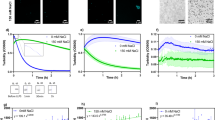Abstract
Intracellular compartmentalization through liquid-liquid phase separation is an emerging organizing principle of cell biology. These compartments, such as the nucleolus and stress granules, are collectively known as membraneless organelles or biomolecular condensates. In vitro studies of many protein components of biomolecular condensates, such as the intrinsically disordered regions of Ddx4, FUS, and Laf-1 proteins, have revealed much about the driving forces of the phase separation process. A common approach is to investigate how the temperature at which a protein solution forms condensates—the transition temperature—responds to changes in the solution composition. We describe a method to measure the in vitro transition temperature of a sub-10 μL sample of a phase-separating solution using transmitted light microscopy. Through monitoring changes in transition temperature with solution conditions, this approach allows the impact of additional biomolecules and additives to be quantitatively assessed and permits the construction of phase diagrams.
Access this chapter
Tax calculation will be finalised at checkout
Purchases are for personal use only
Similar content being viewed by others
References
Nott TJ, Petsalaki E, Farber P et al (2015) Phase transition of a disordered nuage protein generates environmentally responsive membraneless organelles. Mol Cell 57(5):936–947
Brangwynne CP, Eckmann CR, Courson DS et al (2009) Germline P granules are liquid droplets that localize by controlled dissolution/condensation. Science 324:1729–1732
Sheu-Gruttadauria J, MacRae IJ (2018) Phase transitions in the assembly and function of human miRISC. Cell 173:946–957.e16
Schuster BS, Reed EH, Parthasarathy R et al (2018) Controllable protein phase separation and modular recruitment to form responsive membraneless organelles. Nat Commun 9:2985
Li P, Banjade S, Cheng H-C et al (2012) Phase transitions in the assembly of multivalent signalling proteins. Nature 483:336–340
Molliex A, Temirov J, Lee J et al (2015) Phase separation by low complexity domains promotes stress granule assembly and drives pathological fibrillization. Cell 163:123–133
Franzmann TM, Jahnel M, Pozniakovsky A et al (2018) Phase separation of a yeast prion protein promotes cellular fitness. Science 359:eaao5654
Banani SF, Lee HO, Hyman AA et al (2017) Biomolecular condensates: organizers of cellular biochemistry. Nat Rev Mol Cell Biol 18:285–298
Shin Y, Brangwynne CP (2017) Liquid phase condensation in cell physiology and disease. Science 357:6357
Feric M, Vaidya N, Harmon TS et al (2016) Coexisting liquid phases underlie nucleolar subcompartments. Cell 165:1686–1697
Wegmann S, Eftekharzadeh B, Tepper K et al (2018) Tau protein liquid–liquid phase separation can initiate tau aggregation. EMBO J 37:e98049
Elbaum-Garfinkle S, Kim Y, Szczepaniak K et al (2015) The disordered P granule protein LAF-1 drives phase separation into droplets with tunable viscosity and dynamics. Proc Natl Acad Sci U S A 112(23):7189–7194
Wang J, Choi J-M, Holehouse AS et al (2018) A molecular grammar governing the driving forces for phase separation of prion-like RNA binding proteins. Cell 174:688–699.e16
Simon JR, Carroll NJ, Rubinstein M et al (2017) Programming molecular self-assembly of intrinsically disordered proteins containing sequences of low complexity. Nat Chem 9:509–515
Aumiller WM, Pir Cakmak F, Davis BW et al (2016) RNA-based coacervates as a model for membraneless organelles: formation, properties, and interfacial liposome assembly. Langmuir 32:10042–10053
Shultz AR, Flory PJ (1952) Phase equilibria in polymer—solvent systems. J Am Chem Soc 74:4760–4767
Schindelin J, Arganda-Carreras I, Frise E et al (2012) Fiji: an open-source platform for biological-image analysis. Nat Methods 9:676–682
O’Malley R (1983) Physical chemistry, second edition (Atkins, P.W.). J Chem Educ 60:A63
Brangwynne CP, Tompa P, Pappu RV (2015) Polymer physics of intracellular phase transitions. Nat Phys 11:899–904
Gibaud T, Schurtenberger P (2009) A closer look at arrested spinodal decomposition in protein solutions. J Phys Condens Matter 21:322201
Author information
Authors and Affiliations
Corresponding author
Editor information
Editors and Affiliations
Rights and permissions
Copyright information
© 2020 Springer Science+Business Media, LLC, part of Springer Nature
About this protocol
Cite this protocol
Holland, J., Crabtree, M.D., Nott, T.J. (2020). In Vitro Transition Temperature Measurement of Phase-Separating Proteins by Microscopy. In: Kragelund, B.B., Skriver, K. (eds) Intrinsically Disordered Proteins. Methods in Molecular Biology, vol 2141. Humana, New York, NY. https://doi.org/10.1007/978-1-0716-0524-0_36
Download citation
DOI: https://doi.org/10.1007/978-1-0716-0524-0_36
Published:
Publisher Name: Humana, New York, NY
Print ISBN: 978-1-0716-0523-3
Online ISBN: 978-1-0716-0524-0
eBook Packages: Springer Protocols




